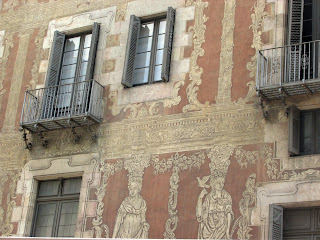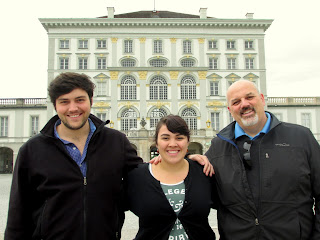Our last day in Barcelona started with a day trip out to Montserrat, an monastery built on a mountain about an hour outside the city. We went with a tour group, which ended up consisting of the guide and her friend, who was either in training as a guide, or just hanging out, the four of us, and a very friendly German woman. We made the drive from the narrow streets of Old Town to the wide, winding roads of the mountain and for the first time since leaving home, felt a little less frazzled, if a little car sick. When we got to the top, we were immediately met with an astounding view of the mountain, dotted with chapels and holy sites, and the sprawling valleys below.
We got a quick walking tour of the main monastery, with its statue-lined courtyards and spectacular facades, while our guide pointed out what there was to do to fill our free time on the mountain. There was an art museum filled with great works by masters from all over the world, from ancient relics up to modern art. Montserrat is also covered with hiking trails, which lead to incredible views, chapels, grave sites, and sculptures. There is also a market filled with local cheeses and honeys, as well as shops selling goods made by the monks of the monastery. The tour lasted about 30 minutes and by the end, we couldn't wait to explore the mountain for ourselves.
The mountain, our guide explained, is famous because of a miracle that happened here. A long time ago, a group of children found a statue, the Black Madonna, in a cave. They told a nearby bishop, who, out of greed, tried to take the statue away. As his men tried to carry it off the mountain, however, she got heavier and heavier, until they could not lift her. That's how they knew that the Black Madonna belonged to the mountain, so she had stayed there ever since. Now, the Black Madonna is on display in a room above the altar in the main church, where visitors and locals go with their petitions and gratitude.
The tour left us in a small side chapel off the main courtyard, in which people had left offerings to the Black Madonna. The room was full with wedding gowns, dolls, juice boxes, photos, money, and letters, all given as thanks. I was overwhelmed and humbled by this tangible display of faith and thanksgiving.
We decided to go to the main church first, and spent a few moments of silence in the dark but elegant church, before going to see the Black Madonna up close. When we left the church, however, we found we had just missed the viewing time, so our view from the pews would have to suffice.
We decided that, despite our inappropriate footwear, a hike was in order. Following our guide's recommendation, we found our way to the rear of the monastery and started up the trail to an incredible overlook we'd seen on our way in.
Unfortunately, we quickly took the wrong turn, but we ended up on a path that showed the Stations of the Cross (the sequence of events in Jesus' death) in modernist sculpture. Even though it was not what we had originally planned, the views and the sculptures were beautiful.
We had almost reached the end of our free time, so we went back to the main monastery area, visited the market and the monastery shops, where we sampled a few more Catalonian specialties. The first was a little pot of soft white cheese with honey poured over and the second was a long, thin cake made by the monks. Both were, of course, delicious.
We made the drive back to Barcelona, where our tour guide took us to Sagrada Familia Basilica, Gaudí's famous (and ongoing!) masterpiece. Construction began, under Gaudí's close supervision, in 1883 and continues today. After Gaudí's death, construction continued according to his extensive planning and is executed today by numerous world-famous architects and artists. The design of the Basilica was heavily inspired by Montserrat. The facades show the rounded, almost melted look of the mountain and the interior features columns that look extraordinarily like trees. Gaudí's focus was on the use of light within the building design, as he had a personal dislike for the dark gloom of the churches of the time. Although incomplete, Gaudí's vision is clearly visible. The church is scheduled for completion in 2016. We'll see.
We were met with the tiniest surprise, though, when our tour guide said goodbye at Sagrada Familia, as we were most certainly expecting a ride back to when the tour began. Instead, we made the long (not really that long) trek back to La Rambla. When we reached the hotel, we took a few minutes and cleaned up. Deciding to fight through our persistant exhaustion (I've found this a trend in our travels), we got dressed to walk down La Rambla to the port. The end of La Rambla opens up in Barceloneta, the old fishing village, which is now filled with good seafood and bars.
We'd gotten a recommendation from our tour guide for a good place to get tapas, a cultural institution essentially consisting of a series of small plates shared with friends over drinks. Typical Catalonian tapas include Iberian ham, bombas (stuffed rice balls), calamari, anchovies, or fried vegetables. We found the bar she'd recommended and immediately knew she had given a good one. The place was packed and nearly invisible behind the large and boisterous crowd waiting to get it.
Unfortunately, we hadn't had a real meal all day, so we decided to punt (at least for the moment) and grab a few tapas and a drink at a nearby restaurant and try to wait out the crowd. This was a huge mistake.
We ordered a vegetable mix and a seafood mix, both of which were more-than-slightly horrifying. We'd ordered sangria, (we couldn't leave Barcelona without trying it) but where not prepared for the sheer volume and presentation of the drinks. They came in two liter glasses and were set down in front of us with a clunk, each full of a colorful assortment of impractically long straws. Nevertheless, we were not even remotely phased.
After our weird little meal, we reached the conclusion that these were our karmic dues, given our incredible culinary find a few nights ago at Allium. Thoroughly exhausted and perhaps even more thoroughly sangria-ed, we walked back home, taking the beautiful and (frankly) equally unbeautiful sights of La Rambla at night.
The next morning, we made the long, grueling trip home, starting with a 5:00 cab ride and ending almost a full 24 hours later. It was definitely not the best collection of moments of our trip, but the long flights, layovers, and lack of leg room were certainly outweighed by the fabulous, fabulous memories we've accrued over the last two weeks. A huge thank you to those that have followed our travels here on the blog, and of course, to my wonderful family, with whom I've shared this amazing experience.


























































